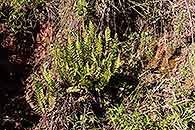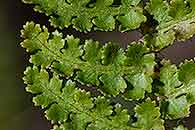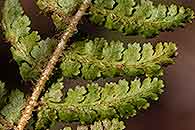Mohria nudiuscula J.P. Roux
Synonyms |
Mohria caffrorum auct. non (L.) Desv. |
|---|---|
Common name |
|
Description |
Rhizome shortly creeping, short, up to 10 mm in diameter; rhizome scales chestnut to rust-coloured, 5-7 mm long, narrowly lanceolate in outline, margin entire. Fronds closely spaced, tufted, few, spreading or erect, up to 90 cm long, slightly dimorphic with fertile fronds slightly longer than sterile fronds. Stipe 2-22 cm long, sparsely to densely set with mixture of hairs and scales, becoming glabrous at maturity. Lamina coriaceous, 5.3-63.5 cm long, narrowly elliptic in outline, pinnate to 2-pinnatifid, with 7-34 pairs of pinnae. Pinnae ovate to narrowly ovate in outline, hairless or nearly so on upper surface, undersurface with hairs and scales along the rhachis and veins; pinnule margins shallowly crenulate to obtusely toothed. Rachis densely set with hairs and scales. Sori marginal at lobe apices, exindusiate. |
Notes | Difficult to distinguish from M. vestita. M. nudiuscula has a thickly coriaceous and often a less dissected lamina with hairless or nearly hairless upper surface; the margins are notched with shallowly rounded teeth. |
Derivation | nudiuscula: somewhat bare or naked, the upper surface of the lamina is almost hairless. |
Habitat | Seasonally moist montane grassland and forest margin, rocky places by waterfalls, exposed or shaded. |
Distribution worldwide | Africa, Madagascar. |
Distribution in Africa |
Dem. Republic of Congo, Lesotho, Malawi, Mozambique, South Africa, Tanzania , Zambia, Zimbabwe. |
Growth form |
Terrestrial. |
Literature |
|





